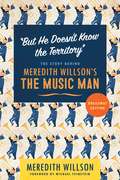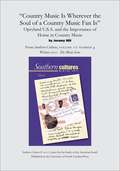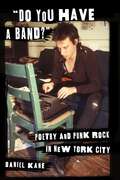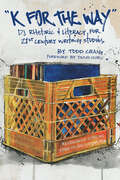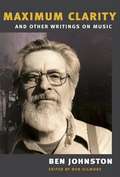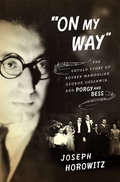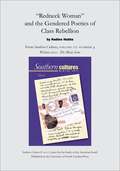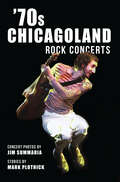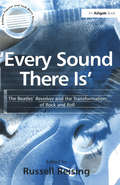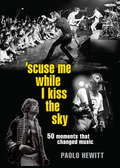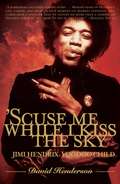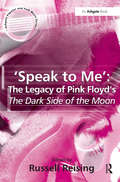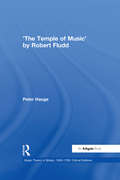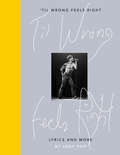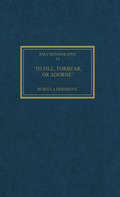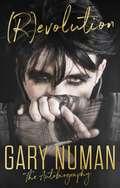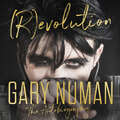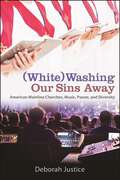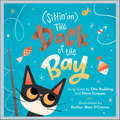- Table View
- List View
"But He Doesn't Know the Territory": The Story behind Meredith Willson's The Music Man
by Meredith WillsonChronicles the creation of Meredith Willson&’s The Music Man—reprinted now as the Broadway Edition Composer Meredith Willson described The Music Man as &“an Iowan&’s attempt to pay tribute to his home state.&” Now featuring a new foreword by noted singer and educator Michael Feinstein, this book presents Willson&’s reflections on the ups and downs, surprises and disappointments, and finally successes of making one of America&’s most popular musicals. Willson&’s whimsical, personable writing style brings readers back in time with him to the 1950s to experience firsthand the exciting trials and tribulations of creating a Broadway masterpiece. Fresh admiration of the musical—and the man behind the music—is sure to result.
"Country Music is Wherever the Soul of a Country Music Fan Is": Opryland U.S.A. and the Importance of Home in Country Music
by Jeremy HillNixon's visit (only five months before his resignation) was seen by national journalists and politicos to be a trip to one of the few places where he would still receive a warm reception, and it was quite warm indeed. Nixon took the stage, played two songs on the piano, and bantered with Roy Acuff."When the Opry changed sites it wasn't without a good deal of growing pains, angst, and rhetoric--but by taking old values to the new venue, not to mention a circle of the original old floor, country music survived the switch.This article appears in the 2011 Music issue of Southern Cultures.Southern Cultures is published quarterly (spring, summer, fall, winter) by the University of North Carolina Press. The journal is sponsored by the University of North Carolina at Chapel Hill's Center for the Study of the American South.
"Do You Have a Band?": Poetry and Punk Rock in New York City
by Daniel KaneDuring the late 1960s, throughout the 1970s, and into the 1980s, New York City poets and musicians played together, published each other, and inspired one another to create groundbreaking art. In "Do You Have a Band?", Daniel Kane reads deeply across poetry and punk music to capture this compelling exchange and its challenge to the status of the visionary artist, the cultural capital of poetry, and the lines dividing sung lyric from page-bound poem.Kane reveals how the new sounds of proto-punk and punk music found their way into the poetry of the 1960s and 1970s downtown scene, enabling writers to develop fresh ideas for their own poetics and performance styles. Likewise, groups like The Fugs and the Velvet Underground drew on writers as varied as William Blake and Delmore Schwartz for their lyrics. Drawing on a range of archival materials and oral interviews, Kane also shows how and why punk musicians drew on and resisted French Symbolist writing, the vatic resonance of the Beat chant, and, most surprisingly and complexly, the New York Schools of poetry. In bringing together the music and writing of Richard Hell, Patti Smith, and Jim Carroll with readings of poetry by Anne Waldman, Eileen Myles, Ted Berrigan, John Giorno, and Dennis Cooper, Kane provides a fascinating history of this crucial period in postwar American culture and the cultural life of New York City.
"I Hear America Singing": Folk Music and National Identity
by Rachel Clare DonaldsonFolk music is more than an idealized reminder of a simper past. It reveals a great deal about present-day understandings of community and belonging. It celebrates the shared traditions that define a group or nation. In America, folk music--from African American spirituals to English ballads and protest songs--renders the imagined community more tangible and comprises a critical component of our diverse national heritage. In "I Hear America Singing," Rachel Donaldson traces the vibrant history of the twentieth-century folk music revival from its origins in the 1930s through its end in the late 1960s. She investigates the relationship between the revival and concepts of nationalism, showing how key figures in the revival--including Pete Seeger , Alan Lomax, Moses Asch, and Ralph Rinzler--used songs to influence the ways in which Americans understood the values, the culture, and the people of their own nation. As Donaldson chronicles how cultural norms were shaped over the course of the mid-twentieth century, she underscores how various groups within the revival and their views shifted over time. "I Hear America Singing" provides a stirring account of how and why the revivalists sustained their culturally pluralist and politically democratic Americanism over this tumultuous period in American history.
"K for the Way": DJ Rhetoric and Literacy for 21st Century Writing Studies
by Todd Craig“K for the Way” explores writing, rhetoric, and literacy from the perspective of the Hip Hop DJ. Todd Craig, a DJ himself, establishes and investigates the function of DJ rhetoric and literacy, illuminating the DJ as a fruitful example for (re)envisioning approaches to writing, research, and analysis in contemporary educational settings. Because it is widely recognized that the DJ was the catalyst for the creation of Hip Hop culture, this book begins a new conversation in which Hip Hop DJs introduce ideas about poetics and language formation through the modes, practices, and techniques they engage in on a daily basis. Using material from a larger qualitative research study that illustrates the Hip Hop DJ as a twenty-first-century new media reader, writer, and literary critic, Craig blends interviews from prominent and influential DJs in the Hip Hop community with narrative and interdisciplinary scholarship from writing studies, Hip Hop studies, African American studies, urban education, and ethnomusicology. The voices of DJs sit front and center, presenting a revolutionary conversation about writing and communication in the twenty-first century. Weaving Craig’s life experiences with important discussions of racial literacies, “K for the Way” is a layered and utterly singular exploration of culture, identity, and literacy in America.
"MAXIMUM CLARITY" AND OTHER WRITINGS ON MUSIC
by Ben Gilmore Ben JohnstonDescribed by New York Times critic John Rockwell as "one of the best non-famous composers this country has to offer," Ben Johnston reconceives familiar idioms--ranging from jazz to Southern hymns--using just intonation. Johnston studied with Darius Milhaud, Harry Partch, and John Cage, and is best known for his String Quartet No. 4, a complex series of variations on Amazing Grace. This volume reveals he is also a truly literate composer, who writes and speaks about music with eloquence and charm. "Maximum Clarity" and Other Writings on Music spans forty years and brings together forty-one of Johnston's most important writings, including many rare and several previously unpublished selections. They include position papers, theoretical treatises, program notes, historical reflections, lectures, excerpts from interviews, and letters, and they cover a broad spectrum of concerns--from the technical exegesis of microtonality to the personal and the broadly humanistic. The volume concludes with a discography of all commercially available recordings of Johnston's music.
"On My Way": The Untold Story of Rouben Mamoulian, George Gershwin, and Porgy and Bess
by Joseph HorowitzA revelatory history of the operatic masterpiece that both made and destroyed Rouben Mamoulian, its director and unsung hero. "Bring my goat!" Porgy exclaims in the final scene of Gershwin's opera Porgy and Bess. Bess, whom he loves, has left for New York City, and he's determined to find her. When his request is met with astonishment--New York is a great distance from South Carolina's Catfish Row--Porgy remains undaunted. He mounts his goat-cart and leads the community in an ecstatic finale, "Oh Lawd, I'm on my way." Stephen Sondheim has called "Bring my goat!" "one of the most moving moments in musical theater history." For years it was assumed that DuBose Heyward--the author of the seminal novella and subsequent play, Porgy, and later the librettist for the opera Porgy and Bess--penned this historic line. In fact, both it and "Oh Lawd, I'm on my way" were added to the play eight years earlier by that production's unheralded architect: Rouben Mamoulian. Porgy and Bess as we know it would not exist without the contributions of this master director. Culling new information from the recently opened Mamoulian Archives at the Library of Congress, award-winning author Joseph Horowitz shows that, more than anyone else, Mamoulian took Heyward's vignette of a regional African-American subculture and transformed it into an epic theater work, a universal parable of suffering and redemption. Part biography, part revelatory history, "On My Way" re-creates Mamoulian's visionary style on stage and screen, his collaboration with George Gershwin, and the genesis of the opera that changed the face of American musical life.
"Redneck Woman" and the Gendered Poetics of Class Rebellion
by Nadine HubbsIn 2004 Gretchen Wilson exploded onto the country music scene with 'Redneck Woman.' The blockbuster single led to the early release of her first CD and propelled it to triple platinum sales."Gretchen Wilson celebrates a new kind Virile Woman on the country music scene--but this subtle gender analysis reveals much more than immediately meets the eye.This article appears in the 2011 Music issue of Southern Cultures.Southern Cultures is published quarterly (spring, summer, fall, winter) by the University of North Carolina Press. The journal is sponsored by the University of North Carolina at Chapel Hill's Center for the Study of the American South.
'70s Chicagoland Rock Concerts
by Mark Plotnick Jim SummariaA Portal to Rock 'N' Roll History During the 1970s, Chicagoland venues hosted an eclectic mix of legendary rock 'n' roll acts that thrilled audiences. Fans flocked to historic venues like the Auditorium Theater, International Amphitheatre, Arie Crown Theatre, Kinetic Playground and B'Ginnings to forge relationships and hear music that shaped their youth and endured a lifetime. Acts like Led Zeppelin, the Who, Rolling Stones, Black Sabbath, Wings, Genesis and so many others took the stage here during rock's most prolific and memorable era. Jim Summaria and Mark Plotnick bring those mind-blowing performances back to life with exclusive concert photos, histories, trivia and more.
'Blerwytirhwng?' The Place of Welsh Pop Music
by Sarah HillIn the 1960s, Welsh-language popular music emerged as a vehicle for mobilizing a geographically dispersed community into political action. As the decades progressed, Welsh popular music developed beyond its acoustic folk roots, adopting the various styles of contemporary popular music, and ultimately gaining the cultural self-confidence to compete in the Anglo-American mainstream market. The resulting tensions, between Welsh and English, amateur and professional, rural and urban, the local and the international, necessitate the understanding of Welsh pop as part of a much larger cultural process. Not merely a 'Celtic' issue, the cultural struggles faced by Welsh speakers in a predominantly Anglophone environment are similar to those faced by innumerable other minority communities enduring political, social or linguistic domination. The aim of 'Blerwytirhwng?' The Place of Welsh Pop Music is to explore the popular music which accompanied those struggles, to connect Wales to the larger Anglo-American popular culture, and to consider the shift in power from the dominant to the minority, the centre to the periphery. By surveying the development of Welsh-language popular music from 1945-2000, 'Blerwytirhwng?' The Place of Welsh Pop examines those moments of crisis in Welsh cultural life which signalled a burgeoning sense of national identity, which challenged paradigms of linguistic belonging, and out of which emerged new expressions of Welshness.
'Every Sound There Is': The Beatles' Revolver and the Transformation of Rock and Roll
by Russell Reising'Every Sound There Is': Revolver and the Transformation of Rock and Roll assesses and celebrates the Beatles' accomplishment in their 1966 masterpiece. The essays of Every Sound There Is examine Revolver from a large number of complementary starting points that help us to understand both the album's contemporary creation and reception and the ways in which it continues to shape the creation and reception of popular music in the twenty-first century. Responding to the incredible diversity of Revolver, this gathering of international scholars focuses on the Beatles' 1966 album as one of rock and roll history's threshold moments. Bringing to bear approaches from the disciplines of musicology, cultural studies, poetics, gender studies, these essays address matters as diverse as the influence of American R&B on Revolver as well as its influence on Pink Floyd, each Beatle‘s contributions to the album, the musicological significance of the Beatles' harmonies and chord progressions, its status and coherence as a work of art, the technological and marketing significance of Revolver's recording and distribution, and its influence on the development of rock music.
'Rock On': Women, Ageing and Popular Music (Ashgate Popular and Folk Music Series)
by Abigail GardnerFor female pop stars, whose star bodies and star performances are undisputedly the objects of a sexualized external gaze, the process of ageing in public poses particular challenges. Taking a broadly feminist perspective, 'Rock On': women, ageing and popular music shifts popular music studies in a new direction. Focussing on British, American and Latina women performers and ageing, the collection investigates the cultural work performed by artists such as Shirley Bassey, Petula Clark, Madonna, Celia Cruz, Grace Jones and Courtney Love. The study crosses generations of performers and audiences enabling an examination of changing socio-historical contexts and an exploration of the relationships at play between performance strategies, star persona and the popular music press. For instance, the strategies employed by Madonna and Grace Jones to engage with the processes and issues related to public ageing are not the same as those employed by Courtney Love or Celia Cruz. The essays in this insightful collection reflect on the ways that artists and fans destabilise both the linear trajectories and the compelling weight of expectations regarding ageing by employing different modalities of resistance through persona re-invention, nostalgia, postmodern intertextuality and even early death as the ultimate denial of age.
'Scuse Me While I Kiss the Sky: 50 Moments That Changed Music
by Paolo HewittFrom the moment that Ike Turner and the Kings of Rhythm conceived 'Rocket 88' to the suicide of Nirvana lead singer Kurt Cobain and Lennon's Anniversary concert, 'Scuse Me While I Kiss the Sky chronicles 50 moments in history that shaped rock and roll as we know it. The stories of behind the iconic records and recordings, the untimely deaths, landmark live performances, on-screen incidents and all of the most outrageous moments are recounted in this captivating, comprehensive overview of the greatest musical form of the twentieth century. Paolo Hewitt's lively and readable text gives us a unique 'insider's view' on each event explaining the background and immediate aftermath to the moment as well as its long term significance and legacy. Each story is accompanied by an 'at a glance' box about each artist, their most significant achievements and contribution to rock history. Iconic moments include: First show of the Beatles at the Cavern; First show of the Rolling Stones at Eel Pie Island; Dylan goes electric at the Newport Folk festival; The Beach Boys' 'Good Vibrations' is the first pop hit to employ electronic sounds; The Ramones debut at the CBGB's and launch punk-rock; The Sex Pistols singer Johnny Rotten is attacked in a car park by a razor-wielding man incensed by the band's anti royalty single, God Save The Queen; The Clash's 'London Calling' mixes punk-rock with reggae, ska, funk, blues, etc; The Talking Heads' Fear Of Music, produced by Brian Eno, fuses new wave and funk, and invents 'techno-funk'; Sid Vicious and Nancy Spungen die at the Chelsea hotel; Ozzy Osborne bites the head off a bat and urinates on the Alamo; MTV debuts on cable TV with the Buggles' 'Video Killed The Radio Star'; Born In the USA is appropriated by Ronald Reagan for his election campaign; Live Aid concert; The Smiths release their infamous Meat Is Murder album; Kurt Cobain dies; Anniversary concert for Lennon at the Beacon theatre in New York 2010.
'Scuse Me While I Kiss the Sky: 50 Moments That Changed Music
by Paolo HewittFrom the moment that Ike Turner and the Kings of Rhythm conceived 'Rocket 88' to the suicide of Nirvana lead singer Kurt Cobain and Lennon's Anniversary concert, 'Scuse Me While I Kiss the Sky chronicles 50 moments in history that shaped rock and roll as we know it. The stories of behind the iconic records and recordings, the untimely deaths, landmark live performances, on-screen incidents and all of the most outrageous moments are recounted in this captivating, comprehensive overview of the greatest musical form of the twentieth century. Paolo Hewitt's lively and readable text gives us a unique 'insider's view' on each event explaining the background and immediate aftermath to the moment as well as its long term significance and legacy. Each story is accompanied by an 'at a glance' box about each artist, their most significant achievements and contribution to rock history. Iconic moments include: First show of the Beatles at the Cavern; First show of the Rolling Stones at Eel Pie Island; Dylan goes electric at the Newport Folk festival; The Beach Boys' 'Good Vibrations' is the first pop hit to employ electronic sounds; The Ramones debut at the CBGB's and launch punk-rock; The Sex Pistols singer Johnny Rotten is attacked in a car park by a razor-wielding man incensed by the band's anti royalty single, God Save The Queen; The Clash's 'London Calling' mixes punk-rock with reggae, ska, funk, blues, etc; The Talking Heads' Fear Of Music, produced by Brian Eno, fuses new wave and funk, and invents 'techno-funk'; Sid Vicious and Nancy Spungen die at the Chelsea hotel; Ozzy Osborne bites the head off a bat and urinates on the Alamo; MTV debuts on cable TV with the Buggles' 'Video Killed The Radio Star'; Born In the USA is appropriated by Ronald Reagan for his election campaign; Live Aid concert; The Smiths release their infamous Meat Is Murder album; Kurt Cobain dies; Anniversary concert for Lennon at the Beacon theatre in New York 2010.
'Scuse Me While I Kiss the Sky: Jimi Hendrix, Voodoo Child
by David HendersonDavid Henderson's biography of Jimi Hendrix, Jimi Hendrix: Voodoo Child of the Aquarian Age -- first published in hardcover in 1978 -- was described by Greil Marcus of Rolling Stone as "[t]he strongest and most ambitious biography yet written about any rock and roll performer."
'Speak to Me': The Legacy of Pink Floyd's The Dark Side of the Moon
by Russell ReisingThe endurance of Pink Floyd's The Dark Side of the Moon on the Billboard Top 100 Chart is legendary, and its continuing sales and ongoing radio airplay ensure its inclusion on almost every conceivable list of rock's greatest albums. This collection of essays provides indispensable studies of the monumental 1973 album from a variety of musical, cultural, literary and social perspectives. The development and change of the songs is considered closely, from the earliest recordings through to the live, filmed performance at London's Earls Court in 1994. The band became almost synonymous with audio-visual innovations, and the performances of the album at live shows were spectacular moments of mass-culture although Roger Waters himself spoke out against such mass spectacles. The band's stage performances of the album serve to illustrate the multifaceted and complicated relationship between modern culture and technology. The album is therefore placed within the context of developments in late 1960s/early 1970s popular music, with particular focus on the use of a variety of segues between tracks which give the album a multidimensional unity that is lacking in Pink Floyd's later concept albums. Beginning with 'Breathe' and culminating in 'Eclipse', a tonal and motivic coherence unifies the structure of this modern song cycle. The album is also considered in the light of modern day 'tribute' bands, with a discussion of the social groups who have the strongest response to the music being elaborated alongside the status of mediated representations and their relation to the 'real' Pink Floyd.
'The Temple of Music' by Robert Fludd (Music Theory in Britain, 1500–1700: Critical Editions)
by Peter HaugeRobert Fludd (1574-1637) is well known among historians of science and philosophy for his intriguing work, The Metaphysical, Physical and Technical History of both Major and Minor Worlds, in which music plays an important role in his system of neoplatonic correspondences: the harmony of the universe (macrocosm) as well as the harmony of man (microcosm). 'The Temple of Music' (1617-18) is one section of this work, and deals with music theory, practice and organology. Many musicologists today have dismissed his musical ideas as conservative and outmoded or mainly based on fantasy; only the chapters on instruments have received some attention. However, reading Fludd's work on music theory and practice in the context of his own time and comparing it with other contemporary treatises, it is apparent that much of it contains highly original ideas and cannot be considered old fashioned or conservative. It is evident that Fludd's music philosophy influenced and provoked contemporary natural philosophers such as Marin Mersenne and Johannes Kepler. Less well known is the fact that Fludd's music theory reveals aspects of the development of new concepts that appear to reflect contemporary writers on music such as John Coprario and Thomas Campion. Before now, 'The Temple of Music' has not been easily accessible or available, and the fact that Fludd wrote in Latin has also been prohibitive. This critical edition provides the original Latin, an English translation and essential illustrations. The book will therefore be a useful tool for understanding the position of English music theory around 1600.
'Til Wrong Feels Right: Lyrics and More
by Iggy PopThe Godfather of Punk and frontman for The Stooges offers insight into his creative world with this collection of lyrics brought to life by photos, never-before-seen notes and memorabilia, short pieces by Iggy, and commentary from other music legends, including Danny Fields and Chris Stein from Blondie. Iggy Pop hasn't left a mark on music; he’s left it battered and bruised. From fronting the legendary proto-punk band The Stooges to being inducted into the Rock and Roll Hall of Fame in 2010 to collaborating with an eclectic mix of artists including David Bowie, Debbie Harry, Jarvis Cocker, Death In Vegas, Underworld and Josh Homme, Iggy has proved himself to be one of music’s most iconic, outrageous and enduring music artists. Coinciding with the fiftieth anniversary of the first and eponymous The Stooges record, here for the first time are Iggy’s collected lyrics, with stunning original photographs, illustrations and his and others' reflections on a genre-defining music career that spans five decades—the ultimate book for every rock and roll fan.
'To fill, forbear, or adorne': The Organ Accompaniment of Restoration Sacred Music
by Rebecca HerissoneThis is the first study to provide a systematic and thorough investigation of continuo realization styles appropriate to Restoration sacred music, an area of performance practice that has never previously been properly assessed. Rebecca Herissone undertakes detailed analysis of a group of organ books closely associated with the major Restoration composers Purcell, Blow and Humfrey, and the London institutions where they spent their professional lives. By investigating the relationship between the organ books' two-stave arrangements and full scores of the same pieces, Herissone demonstrates that the books are subtle sources of information to the accompanist, not just short or skeleton scores. Using this evidence, she formulates a model for continuo realization of this repertory based on the doubling of vocal parts, an approach that differs significantly from that adopted by most modern editors, and which throws into question much of the accepted continuo practice in modern performance of this repertory.
(R)evolution: The Autobiography
by Gary NumanA Daily Mail 'best TV and showbiz memoir' for 2020From humble beginnings in Middlesex, where money was scarce but dreams were encouraged, to the award-winning godfather of electronica, Gary Numan has seen it all. His incredible story can be charted in two distinct parts . . .The first: a stratospheric rise to success quickly followed by a painful decline into near obscurity. At school, Gary fell through the cracks of the system and was expelled. An unlikely but determined popstar, he earned his first record deal aged nineteen and, two years later, had released four bestselling albums and had twice toured the world. But, aged just twenty-five, it felt like it was all over. Gary's early success began to hold him back and he battled to reconcile the transient nature of fame with his Asperger's syndrome.The second: a twenty-plus year renaissance catalysed by a date with a super-fan. Gary catalogues his fifteen-year struggle with crippling debts, his slow, obstacle-laden journey back to the top (and the insecurity that comes with that) and why Savage reaching #2 in 2017 meant more than the heady heights of 1979. Gary also candidly discusses the importance of his fans; why having Asperger's is a gift at times; the inspiration behind the lyrics; flying around the world in 1981; IVF struggles and the joy of fatherhood and his battle with depression and anxiety.(R)evolution is the rollercoaster rise and fall (and rise) of one man, several dozen synthesisers, multiple issues and two desperately different lives. By turns hilarious and deeply moving, this is Gary Numan in his own words - a brutally honest reflection on the man behind the music.
(R)evolution: The Autobiography
by Gary NumanThis audiobook opens and ends with music from Gary Numan's 2021 album IntruderA Daily Mail 'best TV and showbiz memoir' for 2020From humble beginnings in Middlesex, where money was scarce but dreams were encouraged, to the award-winning godfather of electronica, Gary Numan has seen it all. His incredible story can be charted in two distinct parts . . .The first: a stratospheric rise to success quickly followed by a painful decline into near obscurity. At school, Gary fell through the cracks of the system and was expelled. An unlikely but determined popstar, he earned his first record deal aged nineteen and, two years later, had released four bestselling albums and had twice toured the world. But, aged just twenty-five, it felt like it was all over. Gary's early success began to hold him back and he battled to reconcile the transient nature of fame with his Asperger's syndrome.The second: a twenty-plus year renaissance catalysed by a date with a super-fan. Gary catalogues his fifteen-year struggle with crippling debts, his slow, obstacle-laden journey back to the top (and the insecurity that comes with that) and why Savage reaching #2 in 2017 meant more than the heady heights of 1979. Gary also candidly discusses the importance of his fans; why having Asperger's is a gift at times; the inspiration behind the lyrics; flying around the world in 1981; IVF struggles and the joy of fatherhood and his battle with depression and anxiety.(R)evolution is the rollercoaster rise and fall (and rise) of one man, several dozen synthesisers, multiple issues and two desperately different lives. By turns hilarious and deeply moving, this is Gary Numan in his own words - a brutally honest reflection on the man behind the music.
(R)evolution: The Autobiography
by Gary NumanA Daily Mail 'best TV and showbiz memoir' for 2020From humble beginnings in Middlesex, where money was scarce but dreams were encouraged, to the award-winning godfather of electronica, Gary Numan has seen it all. His incredible story can be charted in two distinct parts . . .The first: a stratospheric rise to success quickly followed by a painful decline into near obscurity. At school, Gary fell through the cracks of the system and was expelled. An unlikely but determined popstar, he earned his first record deal aged nineteen and, two years later, had released four bestselling albums and had twice toured the world. But, aged just twenty-five, it felt like it was all over. Gary's early success began to hold him back and he battled to reconcile the transient nature of fame with his Asperger's syndrome.The second: a twenty-plus year renaissance catalysed by a date with a super-fan. Gary catalogues his fifteen-year struggle with crippling debts, his slow, obstacle-laden journey back to the top (and the insecurity that comes with that) and why Savage reaching #2 in 2017 meant more than the heady heights of 1979. Gary also candidly discusses the importance of his fans; why having Asperger's is a gift at times; the inspiration behind the lyrics; flying around the world in 1981; IVF struggles and the joy of fatherhood and his battle with depression and anxiety.(R)evolution is the rollercoaster rise and fall (and rise) of one man, several dozen synthesisers, multiple issues and two desperately different lives. By turns hilarious and deeply moving, this is Gary Numan in his own words - a brutally honest reflection on the man behind the music.
(White)Washing Our Sins Away: American Mainline Churches, Music, Power, and Diversity
by Deborah JusticeWhat if simply changing musical styles could resurrect social power and religious vitality? By the early 1990s, Christianity was losing ground nationally, and mainline Protestants were trending even Whiter and older than America's overall demographic trajectory. The churches knew they needed to diversify. Yet, many mainline churches focused their energies on the so-called Worship Wars, intense aesthetic and theological controversies running through much of White Christian America. Historically, churches had only supported one musical style; now, many mainline Protestant congregations were willing to risk internal schism to support both Contemporary worship—centered around guitars, praise bands, and choruses—and Traditional worship with its pipe organs, chancel choirs, and hymns. Surely, they thought, musical diversity would broadcast tolerance and bring in new members—perhaps it would even help them regain their historically central role in American society. Based on years of ethnographic research, (White)Washing Our Sins Away explores how American mainline Protestants used internal musical controversies to negotiate their shifting position within the nation's diversifying religious and sociopolitical ecosystems.
**Missing** (LyricPop)
by Steve Cropper Otis ReddingOtis Redding and Steve Cropper's timeless ode to never-ending days is given fresh new life in this heartwarming picture book.“This amiable story can be taken at face value about the power of kindness, or can offer children an introduction to music as well as songwriting. A great summer-day song with such cheerful art makes it easy to recommend this.” —School Library Journal"Sittin’ in the mornin’ sunI’ll be sittin’ when the evening comesWatching the ships roll inThen I’ll watch ’em roll away again, yeah . . ."(Sittin’ on) The Dock of the Bay is a charming picture book set to one of the King of Soul’s™ greatest hits. The song was one of the last Redding recorded, and ranked number four on Billboard’s year-end Hot 100 chart, going on to win two GRAMMYs and be certified triple-platinum.With lyrics by Otis Redding and Steve Cropper and illustrations by Kaitlyn Shea O’Connor, this picture book imagines a lonesome cat fishing off a dock and hoping the fish will bite soon. (Sittin’ on) The Dock of the Bay is the perfect picture book for parents wanting to share a classic song with their children, allowing both to find joy in it along the way.
**Missing**: A Children's Picture Book (LyricPop #0)
by Steve Cropper Otis ReddingIncluded in Publishers Weekly's Spring 2021 Children's Sneak Previews Otis Redding and Steve Cropper's timeless ode to never-ending days is given fresh new life in this heartwarming picture book. Sittin' in the mornin' sun I'll be sittin' when the evening comes Watching the ships roll in Then I'll watch 'em roll away again, yeah (Sittin' on) The Dock of the Bay is a charming picture book set to one of the King of Soul's™ greatest hits. The song was one of the last Redding recorded, and ranked number four on Billboard's year-end Hot 100 chart, going on to win two GRAMMYs and be certified triple-platinum. With lyrics by Otis Redding and Steve Cropper and illustrations by Kaitlyn Shea O'Connor, this picture book imagines a lonesome cat fishing off a dock and hoping the fish will bite soon. (Sittin' on) The Dock of the Bay is the perfect picture book for parents wanting to share a classic song with their children, allowing both to find joy in it along the way. The Otis Redding Foundation: Redding was dedicated to improving the quality of life for his community through the education and empowerment of its youth. He provided scholarships and summer music programs which continued until his untimely death on December 10, 1967. Today, the mission of the Otis Redding Foundation, established in 2007 by Mrs. Zelma Redding, is to empower, enrich, and motivate all young people through programs involving music, writing, and instrumentation. To learn more, visit: otisreddingfoundation.org
